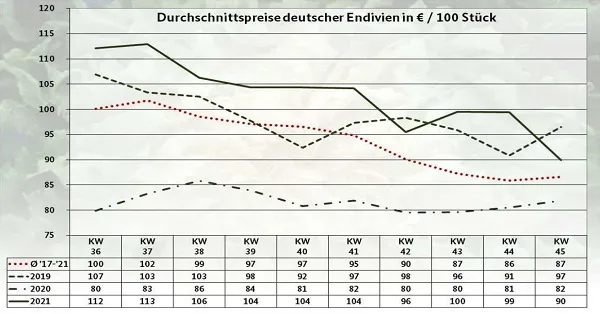Regarding lettuces; the domestic season was nearing its conclusion. Deliveries were winding down, Belgian shipments outweighed the Italian ones. The latter were, however, cheaper and could therefore be sold off more quickly. The prices of the Belgian goods mostly trended downward, those of the domestic ones went up. In Frankfurt, Dutch batches supplemented the range. There were also domestic red products, which could be sold without problems at €6.50 per 9-pack.
Looking at iceberg lettuces, there, it was almost exclusively Spanish products. Only in Cologne, there were Dutch products as well. Domestic products had disappeared from the scene. Due to the lack of competition, prices often went up, but this noticeably slowed down the subsequent sales in Hamburg. In the Hanseatic city, traders then lowered their prices again.
In the colored salad sector, large calibers were popular. In general, the range consisted of domestic and Belgian items. In Frankfurt, the first French goods appeared, costing €9.00 per 9. Italian deliveries rounded off the markets in isolated cases. In the case of endives, the presence of Italian arrivals increased noticeably: At the same time, German supplies became scarcer. The demand was generally satisfied without any problems. Prices remained stable here and there, but mostly showed a downward trend.

Apples
Once again, domestic Elstar, Jonagold and Boskoop predominated. In terms of importance, Pinova, Royal Gala and Braeburn followed in almost equal proportions.
Pears
The markets were sufficiently supplied. Sales were very slow. The traders rarely had cause to change their previous prices.
Table grapes
Italian batches predominated. In general, sales improved only towards the weekend. As supply and demand were sufficiently balanced, prices changed very rarely.
Small citrus fruits
Spanish satsumas dominated the market, but the relevance of Turkish satsumas grew considerably in Munich and Frankfurt. Spanish batches predominated in clementines. Business was quiet.
Lemons
Spanish Primofiori were found most often, with Turkish Meyer lemons coming in second. South African lots increasingly revealed quality problems, which led to more difficult sales.
Bananas
The supply of the ripening plants sufficiently harmonized with customer demand. Price changes were rare.
Cauliflower
The German season was entering the home stretch: Deliveries tapered off. However, as a result of increased shipments from Italy, demand could generally be met.
Cucumbers
Spanish cucumbers clearly dominated the market: their presence increased. The season for Central European products was already well advanced, and the relevance of Belgian, Dutch and domestic lots was massively limited.
Tomatoes
It was possible to access a wide-ranging and quite extensive offer. Demand could generally be met. Prices developed unevenly.
Sweet peppers
Spanish items dominated the market and continuously grew in importance. Turkish imports also gained strength, while the presence of the formerly predominant Dutch batches weakened.
Source: BLE
